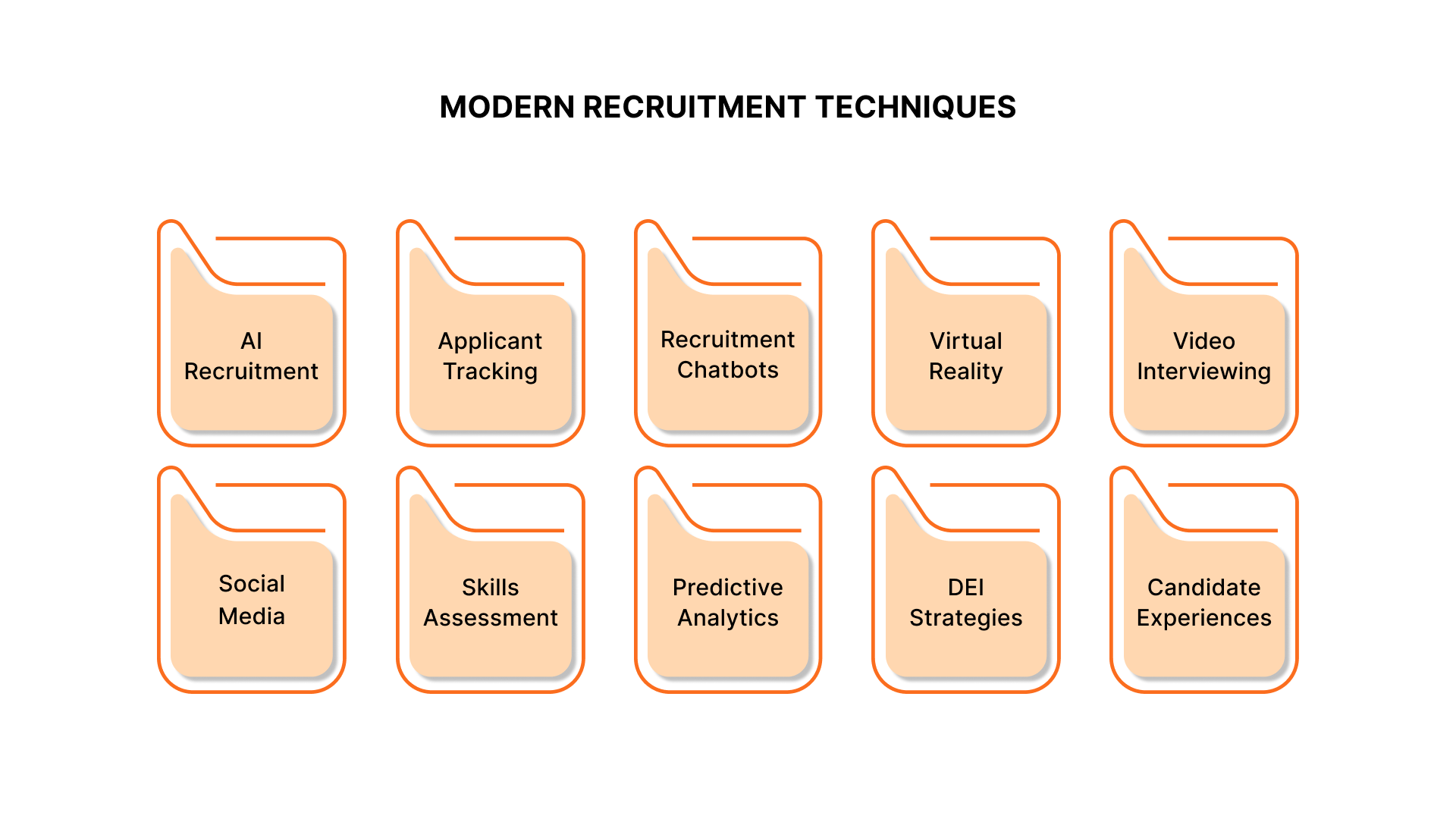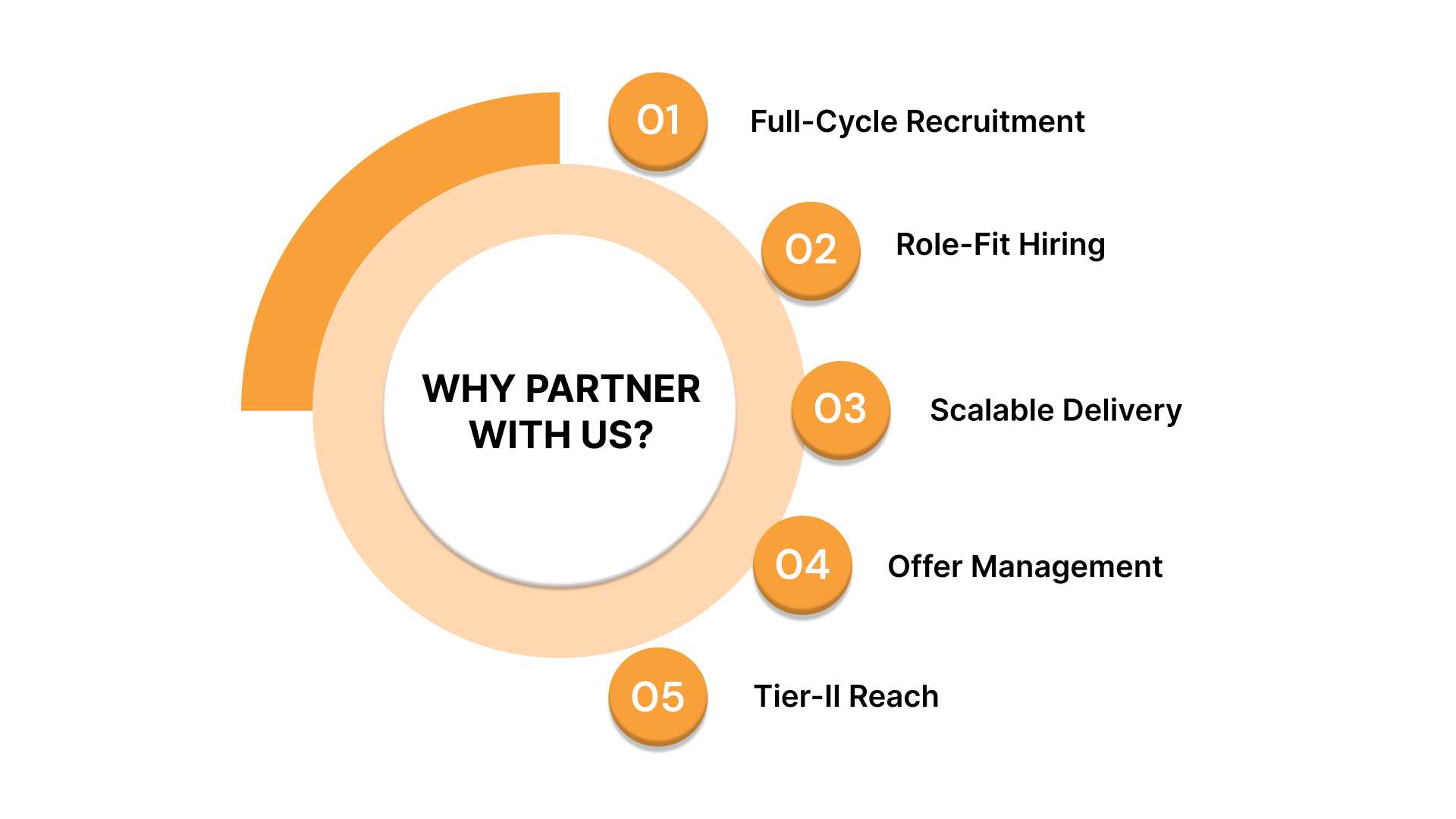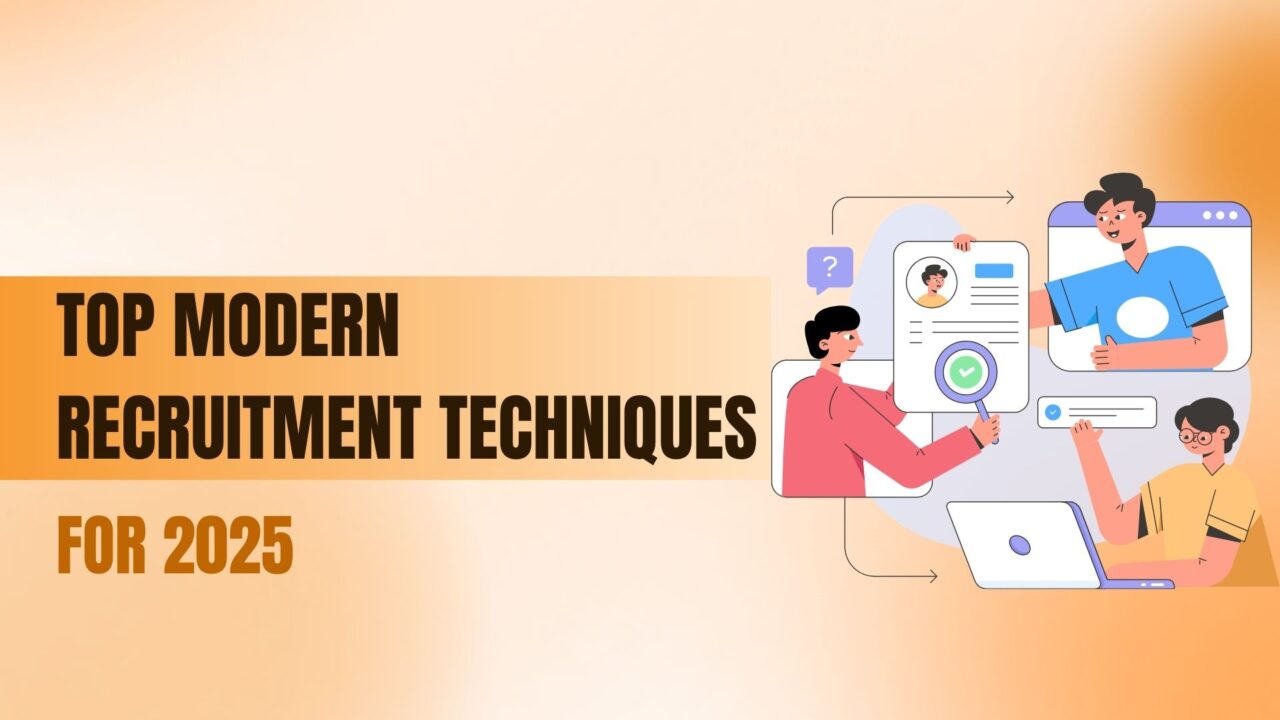As businesses race to build a future-ready workforce in a digital-first world, recruitment in 2025 is becoming smarter, faster, and more candidate-centric. Shaped by emerging technologies, shifting employee expectations, and evolving business models, the hiring function is undergoing a strategic overhaul.
Modern recruitment techniques are replacing outdated methods, enabling organisations to meet rising talent demands across sectors such as IT, BFSI, engineering, and shared services. In this environment, precision, agility, and a data-driven approach are critical.
AI-powered tools, predictive analytics, and immersive assessments are helping employers make faster, more informed decisions while strengthening their brand in key markets like Hyderabad, Bengaluru, Chennai, Pune, Delhi NCR, and Mumbai.
This article explores the top modern recruitment techniques transforming hiring in 2025.
Key Takeaways:
- Modern hiring relies on AI, automation, and data to reduce costs and accelerate decision-making.
- Candidate experience is improved through chatbots, personalization, and transparent, tech-driven communication.
- Tools like virtual interviews and VR expand access to diverse talent, including Tier II and global markets.
- Predictive analytics and skills-first approaches improve hiring accuracy, reduce bias, and support long-term planning.
How Modern Recruitment Techniques Are Changing Recruiting?
Modern recruitment techniques are not just improving hiring efficiency, they are transforming recruitment into a strategic, data-led function. Organisations are using AI, automation, and analytics to optimise processes, improve outcomes, and deliver a superior experience to both candidates and hiring managers.
Key shifts driven by these techniques include:

- Faster hiring and reduced costs through automated screening, AI shortlisting, and simplified workflows.
- Improved candidate experience via personalised engagement, chatbot support, and transparent communication, improving employer brand equity.
- Wider talent reach enabled by virtual interviews and online assessments, allowing access to candidates across regions, including Tier II cities and global locations.
- Data-backed decision-making replacing subjective assessments, resulting in better role fit and reduced attrition.
- Greater focus on diversity and skills with tools that minimise bias, prioritise capabilities over credentials, and support long-term workforce planning.
These evolving dynamics are positioning recruitment as a critical driver of organisational growth and resilience in 2025.
Read More: 5 Ways Recruitment Agencies Can Tackle High Attrition Rates.
Top 10 Modern Recruitment Techniques for 2025

To stay competitive, organisations must adopt innovative methods that address today’s complex hiring challenges from niche skill shortages to high attrition and evolving candidate expectations.
Below are the top 10 modern recruitment techniques transforming talent acquisition.
1. AI-Powered Recruitment
Artificial Intelligence (AI) has become a cornerstone of modern recruitment, offering intelligent solutions that automate routine tasks, improved decision-making, and accelerate the overall hiring process.
Key Applications:
- Resume Screening: AI tools quickly scan and shortlist candidates based on predefined skills, experience, and role-fit indicators.
- Job Matching: Algorithms assess candidate profiles against job requirements with a high degree of accuracy.
- Predictive Analytics: AI evaluates historical data to forecast candidate success, turnover risk, and future performance.
Benefits:
- Efficiency: Significantly reduces time-to-hire and administrative load.
- Reduced Unconscious Bias: AI minimises human subjectivity by applying consistent criteria.
- Improved Diversity: Broader, unbiased sourcing contributes to more inclusive hiring outcomes.
When integrated thoughtfully, AI transforms recruitment into a faster, fairer, and more scalable function.
2. Advanced Applicant Tracking Systems (ATS)
Modern Applicant Tracking Systems (ATS) have advanced well beyond basic resume repositories. They serve as intelligent hiring platforms that simplify recruitment workflows, centralise candidate data, and support data-driven hiring decisions at scale.
Key Applications:
- Workflow Automation: Automates tasks such as CV parsing, interview scheduling, and follow-ups.
- Candidate Scoring: Uses rule-based and AI-powered scoring to rank applicants based on fit and role requirements.
- Centralised Data: Consolidates all hiring activities, candidate interactions, and performance metrics in one platform.
Benefits:
- Improved Recruiter Productivity: Allows talent teams to focus on strategic tasks over manual processes.
- Informed Decision-Making: Enables consistent, transparent, and performance-aligned hiring backed by real-time data insights.
A well-implemented ATS is foundational for recruitment teams aiming for speed, consistency, and scale.
Struggling to find the right talent at scale? V3 Staffing’s domain-specific recruiters and tech-enabled workflows structuring hiring across roles and geographies, helping you deliver results faster.
3. Recruitment Chatbots for Candidate Engagement
AI-powered recruitment chatbots are transforming how organisations engage with candidates, particularly during the early stages of the hiring process. Acting as intelligent virtual assistants, these bots provide instant responses, simplify communication, and create a smooth experience day or night.
Key Applications:
- Initial Interaction: Chatbots greet candidates on career pages or job portals, offering customised guidance through the application process.
- FAQ Automation: They respond to frequently asked questions regarding job roles, company culture, eligibility, and next steps, reducing recruiter workload.
- Interview Scheduling: Integrated with calendar tools, chatbots automatically schedule interviews, send reminders, and handle rescheduling requests.
- Candidate Nurturing: Bots maintain engagement through personalised messages, updates, and feedback, ensuring candidates stay informed and motivated.
Benefits:
- Improved Candidate Experience: Immediate, relevant interactions increase satisfaction and reduce abandonment during the application process.
- Operational Efficiency: Recruiters save time on repetitive tasks, enabling them to focus on strategic sourcing and evaluation.
- Shorter Hiring Timelines: Automation of early-stage touchpoints accelerates the hiring pipeline without compromising on quality.
In 2025, recruitment chatbots are not merely a convenience; they are a critical component of candidate engagement, employer branding, and end-to-end hiring efficiency.
4. Virtual Reality (VR) in Recruitment
Virtual Reality (VR) is redefining how employers showcase roles and work environments by offering immersive, interactive experiences that go far beyond traditional job descriptions. Forward-thinking organisations are using VR to attract, inform, and engage candidates especially in remote or tech-forward hiring scenarios.
Key Applications:
- Immersive Job Previews: Candidates can explore a simulated version of their future workspace, interact with virtual colleagues, and understand day-to-day responsibilities before accepting an offer.
- Virtual Office Tours: VR allows talent, especially those applying remotely or internationally, to experience office culture, team dynamics, and physical infrastructure from anywhere in the world.
- Scenario-Based Assessments: Some employers now integrate VR into assessments, where candidates must respond to real-life workplace challenges, demonstrating decision-making, collaboration, and problem-solving skills.
Benefits:
- Stronger Employer Branding: VR offers a compelling way to differentiate your brand and create lasting impressions.
- Informed Decision-Making: Candidates gain a realistic understanding of the role, reducing mismatched expectations and early attrition.
- Tech-Savvy Candidate Engagement: Especially effective for Gen Z and digital-native professionals who value innovation and transparency in the hiring process.
VR in recruitment is a strategic tool to build trust, showcase authenticity, and align expectations in an increasingly virtual workforce.
5. Video Interviewing and AI Assessments
Video interviewing both live and asynchronous has become a cornerstone of modern recruitment strategies, enabling organisations to connect with talent swiftly, regardless of geography. Coupled with AI-powered assessments, this approach not only accelerates hiring but also improves consistency and fairness in candidate evaluation.
Types of Interviews:
- Live Video Interviews: Real-time, face-to-face interactions conducted via secure video platforms, replicating the structure of traditional interviews with added scheduling flexibility.
- Asynchronous Interviews: Candidates record responses to pre-set questions at their convenience, allowing recruiters to review submissions on their own time.
AI-Based Assessment Capabilities:
- Speech and Sentiment Analysis: Evaluates tone, clarity, confidence, and relevance of responses.
- Behavioural Insights: Identifies key personality traits, cultural alignment, and cognitive fit.
- Automated Shortlisting: Ranks candidates using structured scoring models, reducing manual screening bias.
Benefits:
- Wider Talent Reach: Eliminates geographical constraints, opening access to national and global talent pools.
- Faster Hiring Cycles: Reduces time spent coordinating interviews and analysing responses.
- Improved Objectivity: AI ensures structured and consistent evaluation criteria, helping reduce unconscious bias.
Video interviewing and AI assessments are not just tools of convenience, they are essential enablers of scalable, inclusive, and future-ready recruitment techniques.
Read more: Top Secure Practices for Remote Hiring: Everything You Must Know.
Need a recruitment partner that moves as fast as your business? V3 Staffing blends assessment tools with agile hiring models to source, evaluate, and onboard high-quality talent with precision and speed.
6. Social Media Talent Sourcing
Social media has become a powerful recruitment channel, allowing organisations to discover, attract, and engage talent where they spend a significant amount of time online. Beyond LinkedIn, platforms like Instagram, X, and TikTok are being strategically utilised to connect with both active and passive candidates, especially younger, digital-native professionals.
Key Applications:
- Platform-Specific Campaigns: Customised recruitment content and job promotions designed for the unique formats and audiences of each platform.
- Targeted Advertising: Paid campaigns that reach niche talent segments based on interests, location, skills, and online behaviour.
- Employer Branding: Sharing authentic stories, employee testimonials, and behind-the-scenes culture to build trust and visibility.
Benefits:
- Engaging Passive Talent: Reach candidates who may not be actively job hunting but are open to new opportunities.
- Building Talent Communities: Creating long-term relationships through consistent content, live sessions, and interaction.
- Social Proof and Advocacy: Likes, shares, and employee participation amplify credibility and broaden organic reach.
By integrating social media into their recruitment techniques, companies not only extend their talent reach but also build stronger, more relatable brands in an increasingly candidate-driven market.
7. Skills-Based Assessment Techniques
As hiring moves beyond academic qualifications and static CVs, skills-based assessment techniques have become a cornerstone of modern recruitment. These methods evaluate a candidate’s real-world abilities, problem-solving mindset, and adaptability, which are factors critical for long-term success.
Key Applications:
- Hackathons and Skill Challenges: Live coding contests, case competitions, or task-based evaluations that simulate actual job responsibilities and develop deeper candidate engagement.
- Online Assessment Platforms: Use of timed, proctored tests or situational judgment scenarios tailored to specific roles and levels of seniority.
- Gamified Evaluation: Interactive tasks that assess cognitive ability, collaboration, and decision-making in a format that’s both scalable and engaging.
Benefits:
- Merit-Based Hiring: Enables fairer comparisons by focusing on practical output rather than background or pedigree.
- Improved Branding: Hosting industry-recognised competitions positions employers as skill-focused and innovation-led.
- Higher Offer Acceptance: Candidates feel more valued and invested after participating in immersive, well-designed assessment journeys.
Incorporating skills-based assessment techniques into recruitment strategies, companies can reduce mismatches, accelerate time-to-hire, and attract high-potential candidates who align with their operational needs and performance culture.
8. Data-Driven Recruitment and Predictive Analytics
As recruitment becomes more strategic in 2025, data-driven decision-making is central to identifying, attracting, and retaining the right talent. Organisations are increasingly utilising big data and predictive analytics to optimise hiring processes, reduce uncertainty, and improve long-term workforce outcomes.
Key Applications:
- Hiring Trend Analysis: Real-time dashboards and historical data reveal which channels, job roles, and geographies yield the best results.
- Predictive Modelling: Algorithms assess historical performance data to forecast candidate success, tenure, and cultural alignment.
- Turnover and Attrition Insights: Analytics help identify early warning signs of disengagement or misfit, reducing costly attrition.
Benefits:
- Evidence-Based Hiring Decisions: Replaces gut-feel assessments with measurable insights.
- Improved Time-to-Fill and Quality-of-Hire: Identifies bottlenecks and success indicators throughout the recruitment funnel.
- Customised Talent Strategies: Enables more accurate workforce planning and role-based sourcing tactics.
By embedding predictive analytics into their recruitment techniques, organisations gain a competitive edge, hiring smarter, faster, and with greater foresight.
Also Read: How Predictive Analytics is Revolutionising Talent Acquisition.
9. DEI-Focused Recruitment Strategies
Diversity, Equity, and Inclusion (DEI) have shifted from compliance goals to essential business priorities. Forward-thinking organisations utilise DEI principles throughout the recruitment lifecycle using technology, data, and intentional strategy to ensure fair access and representation.
Key Applications:
- Bias Reduction Tools: AI-powered platforms that anonymise applications, standardise interviews, and flag biased language in job descriptions.
- DEI Analytics Dashboards: Real-time reporting on diversity metrics across hiring funnels, enabling continuous monitoring and improvement.
- Inclusive Talent Sourcing: Outreach to underrepresented groups through targeted campaigns, diverse job boards, and community partnerships.
Benefits:
- Stronger Team Performance: Diverse teams bring broader perspectives, improve decision-making, and improve problem-solving capabilities.
- Improved Reputation: A visible DEI commitment strengthens reputation and appeals to values-driven candidates.
- Legal and Market Resilience: Equitable hiring practices help mitigate compliance risks and reflect positively in consumer and investor perceptions.
By making DEI-focused recruitment strategies an integral part of hiring, organisations develop workplace equity while building agile, future-ready teams that reflect the diversity of the markets they serve.
10. Personalised Candidate Experiences
Candidate expectations are higher than ever and one-size-fits-all recruitment strategies no longer suffice. Forward-thinking organizations are adopting personalization at every touchpoint to provide a customised, human-centric experience that truly connects with each individual.
Key Applications:
- Customised Communication: Using candidate data to customise job recommendations, messaging tone, and outreach timing across channels.
- CRM-Driven Engagement: Recruitment CRMs help track candidate preferences, career interests, and past interactions, enabling consistent and relevant follow-ups.
- Custom Journeys: From interview scheduling to onboarding, candidates receive curated interactions based on their role, background, and location.
Benefits:
- Higher Engagement and Conversion Rates: Candidates are more likely to respond and stay engaged when they feel understood and valued.
- Stronger Employer Branding: A smooth, respectful recruitment journey improves perception of the organisation regardless of outcome.
- Long-Term Talent Relationships: Even rejected candidates are more likely to reapply or refer others if their experience is handled thoughtfully.
Among today’s modern recruitment techniques, personalisation stands out for its impact on both hiring outcomes and employer reputation, turning candidates into advocates.
From tech talent to CXO leadership roles, V3 Staffing is your recruitment partner for today and tomorrow. We deliver scalable, high-impact talent solutions customised to your business goals.
How V3 Staffing Supports Modern Recruitment Techniques
V3 Staffing brings structure, scalability, and technology integration to every stage of recruitment, enabling organisations to implement modern hiring techniques with confidence and consistency. With a presence in Hyderabad, Bengaluru, Chennai, Pune, Delhi NCR, and Mumbai, V3 serves as a strategic partner to enterprises navigating today’s competitive and evolving talent landscape.
Our services spanning Permanent Recruitment, IT Staffing, RPO, Executive Search, and Temporary Staffing are aligned with the latest recruitment trends such as AI-powered shortlisting, skills-based evaluation, and personalised candidate engagement.
Why partner with us:

- Lifecycle-Based Recruitment Support: From role scoping and sourcing to interview coordination and onboarding, our full-cycle recruitment management ensures timely, tech-enabled hiring.
- Skills-Aligned and Role-Fit Hiring: We utilise domain-specific recruiters and real-time assessment tools to focus on candidate capabilities, team compatibility, and long-term retention.
- Scalable, Tech-Enabled Delivery Models: Whether through RPO or project-based hiring, our models support quick scale-up across geographies using ATS workflows and data-led process visibility.
- Offer-to-Join Management: With structured candidate engagement, documentation assistance, and follow-ups, we improve offer acceptance and joining ratios that’s critical in a high-dropout environment.
- Tier-II City Reach and Succession Planning: Our dedicated sourcing channels extend access to diverse talent pools beyond metro cities, aligning with DEI goals and workforce planning needs.
In the age of modern recruitment techniques where speed, precision, and candidate experience define hiring success, V3 Staffing helps businesses to stay ahead through structured delivery, sector expertise, and outcome-focused recruitment strategies.
Conclusion
Adopting modern recruitment techniques is essential for maintaining competitiveness, agility, and hiring quality in the talent market. Each technique adds value across speed, accuracy, and candidate experience. When applied strategically, these innovations help organisations future-proof their workforce and build high-performing teams.
V3 Staffing enables this transformation with customised hiring models, domain-led sourcing, and SLA-bound execution across permanent, tech, contract, and leadership roles. Whether you’re scaling operations, entering new markets, or improving retention, we help embed the right recruitment techniques at every stage.
Contact us to modernise your recruitment strategy.
FAQs
1. What are the recruitment trends for 2025?
Recruitment in 2025 is driven by AI, predictive analytics, virtual hiring, and personalisation. Companies are focusing on diversity, skills-first hiring, and improving candidate experience using automation, immersive tech, and data-led strategies.
2. What are the modern techniques of recruiting?
Modern recruitment techniques include AI-powered screening, predictive analytics, virtual interviews, recruitment chatbots, VR-based assessments, and personalised candidate engagement. These methods improve hiring speed, accuracy, and experience while reducing bias and operational costs.
3. What is the new recruitment 2025 in India?
Recruitment in India 2025 is tech-enabled, data-driven, and candidate-centric. With growing demand across IT, BFSI, and shared services, companies are adopting AI, RPO models, Tier II sourcing, and immersive digital hiring to meet talent needs efficiently.
4. Which method of recruitment is fastest?
The fastest recruitment method is often internal hiring or employee referrals. These approaches reduce time spent on sourcing, screening, and onboarding, as candidates are already familiar with the company or vouched for by current employees, leading to quicker decision-making and faster placements.
5. Which is the best method of recruitment?
The best recruitment method combines multiple channels, such as job portals, employee referrals, social media, and staffing agencies. This hybrid approach maximizes reach, improves candidate quality, and ensures better alignment with job requirements. The effectiveness depends on the role, industry, and urgency of hiring needs.


